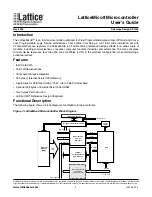
RST
MSP432E4
Microcontroller
R
PU
V
DD
Functional Description
197
SLAU723A – October 2017 – Revised October 2018
Copyright © 2017–2018, Texas Instruments Incorporated
System Control
4. Execution begins.
The internal POR is active only on the initial power-up of the microcontroller, when the microcontroller
wakes from hibernation, and when the VDD supply drops below the its defined operating limit. See the
device-specific data sheet for information on exact values.
4.1.2.4
External Reset Pin
When the external reset pin (RST) is asserted, it initiates a system reset or POR depending on what has
been configured in the Reset Behavior Control (RESBEHAVCTL) Register. If the EXTRES bit field in
RESBEHAVCTL is set to 0x3, a simulated full initialization begins when RST is asserted. If these bits are
programmed to 0x2, a system reset is issued. When EXTRES is set to a 0x0 or 0x1, the external RST pin
performs its default operation when it is asserted, which is issuing a full simulated POR.
An external reset pin (RST) that is configured to generate a POR resets the microcontroller including the
core and all the on-chip peripherals. The external reset sequence is:
1. The external RST pin is asserted for the duration specified by t
MIN
and then deasserted (see the
Specifications
chapter in the device-specific data sheet). This generates an internal POR signal.
2. The microcontroller waits for internal POR to go inactive.
3. The internal reset is released and the core executes a full initialization of the device.
4. When initialization is complete, the core loads from memory the initial stack pointer, the initial program
counter, and the first instruction designated by the program counter
5. Execution begins.
An external RST pin that is configured to generate a system reset will reset the microcontroller including
the core and all the on-chip peripherals. The external reset sequence is:
1. The external reset pin (RST) is asserted for the duration specified by t
MIN
and then deasserted (see the
Specifications
section in the device-specific data sheet).
2. The internal reset is released and the core loads from memory the initial stack pointer, the initial
program counter, and the first instruction designated by the program counter.
3. Execution begins.
NOTE:
Make the trace for the RST signal as short as possible. Place any components connected to
the RST signal as close as possible to the microcontroller.
If the application only uses the internal POR circuit, the RST input must be connected to the power supply
(V
DD
) through an optional pullup resistor (0 to 100 k
Ω
) (see
). The RST input has filtering that
requires a minimum pulse duration for the reset pulse to be recognized (see the device-specific data
sheet).
To improve noise immunity or to delay reset at power up, the RST input can be connected to an RC
network (see
). If the application requires the use of an external reset switch,
shows
the proper circuitry. In the figures, the R
PU
and C
1
components define the power-on delay.
NOTE: R
PU
= 0 to 100 k
Ω
Figure 4-1. Basic RST Configuration
















































